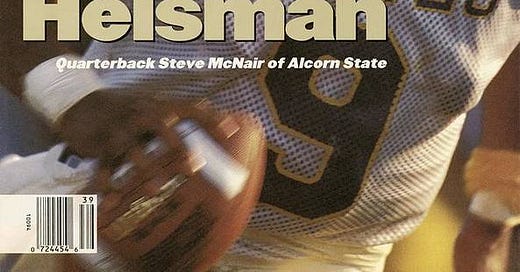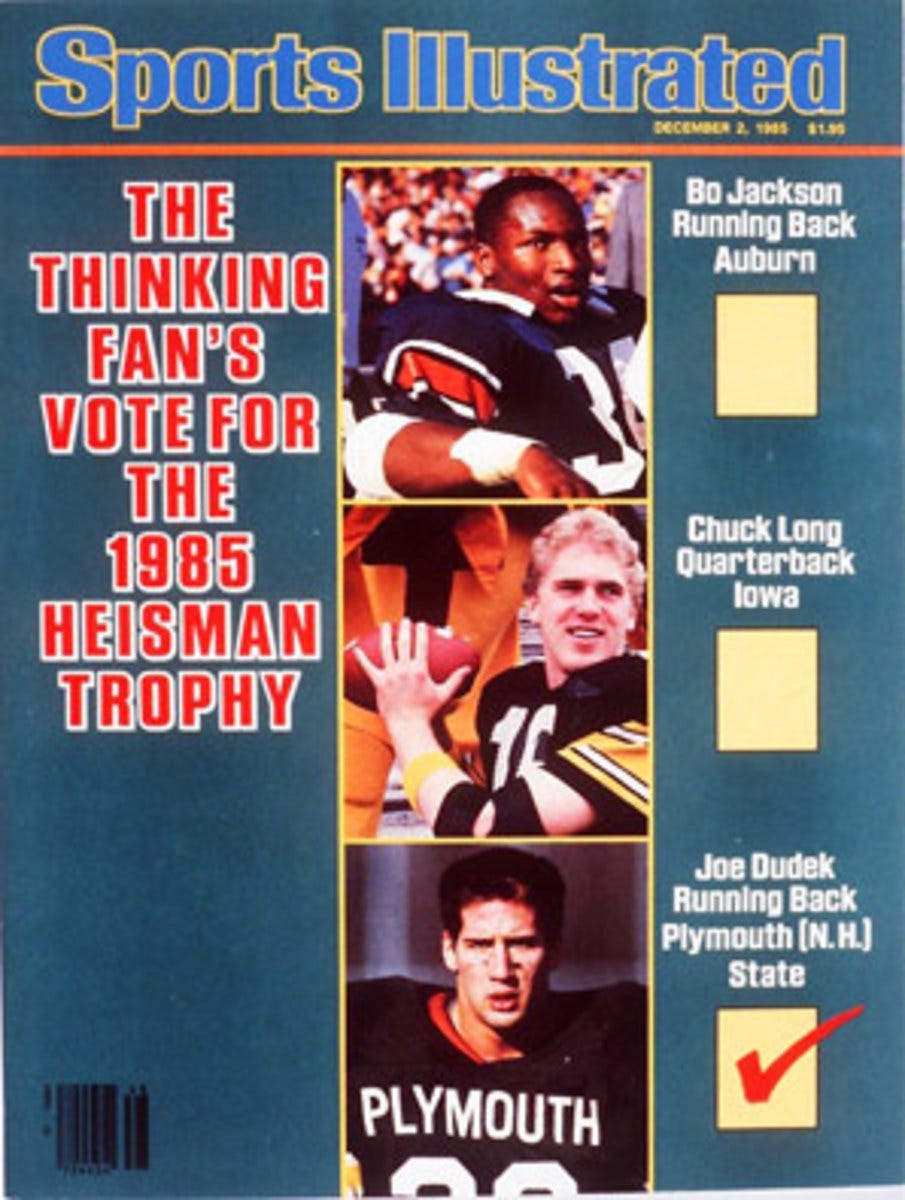Steve McNair & the Heisman Trophy Campaign of 1994
The iconic Sports Illustrated cover story that introduced America to Steve McNair turned 30 last week. How we view underdog stars today is a much less fun than it used to be.
“Hand Him the Heisman,” one of the most iconic covers in Sports Illustrated history, hit newsstands and mailboxes on Sept. 26, 1994. The seminal piece of sports journalism introduced much of the country to Alcorn State Steve McNair, a quarterback whose presence in college football borders on American folklore.
McNair was one of the last of his kind, a superstar thriving in a kind of obscurity that doesn’t exist since the proliferation of the internet. Virtually any game at any level of college football became accessible at the dawn of a new millennium. Following McNair at Alcorn State for those of us outside of the SWAC footprint meant catching highlights on Sportscenter.
Seeing those low-even-by-mid-1990s-standard resolution clips interspersed with ESPN’s coverage of national title contenders like Nebraska and Florida added an additional layer of intrigue to McNair’s play. Those highlights were football’s version of seeing John Henry swing his hammer or the Loch Ness Monster emerge from Scottish waters to snag a low-gliding hawk midflight.
A younger generation may not understand how significant Sportscenter’s coverage of McNair was at the time in part because Sportscenter hardly occupies the same place in the zeitgeist today that it did in the ‘90s.
Likewise, his Sports Illustrated cover carried weight in 1994 that lacks direct parallel today. Viral notoriety, for example, is fleeting; a highlight that blows up on TikTok is unlikely to be remembered with the same reverence 30 days from now that Steve McNair’s SI cover and profile commands 30 years after publish.
And indeed, the article by S.L. Price is brilliant. Price told HBCU Sports for a 2022 retrospective that McNair’s was “the perfect Sports Illustrated story.” It wasn’t the SI cover story that inspired me to pursue sports journalism — that was a 1998 feature on the chaotic existence of Ohio State star linebacker Andy Katzenmoyer — but Price’s piece is the first I remember luring away from my SI for Kids to read my dad’s copy of Sports Illustrated.
Price’s article was also central in shaping how I view the Heisman Trophy. It’s designated for the “best” player in college football, sure. But each season’s race for it and the players chosen to share the stage at the Heisman presentation reflect the story of the sport.
McNair’s campaign for the Heisman Trophy fell short: Colorado running back Rashaan Salaam’s 2,055-yard, 24-touchdown season, coupled with the Penn State backfield of Ki-Jana Carter and Kerry Collins splitting votes, sent the award to Boulder.
But the buzz following McNair and the absolutely staggering numbers he put up in 1994 — 5,377 passing yards and 47 touchdowns with another 904 yards and nine touchdowns via the run — garnered him an invitation to New York.
And quarterback from the Southwestern Athletic Conference being on that stage represented the excellence of those who came before him like Jackson State’s Walter Payton; Jerry Rice and Willie Totten, the Mississippi Valley State receiver-quarterback tandem who, a decade before McNair, helped change the function of passing offense; and Grambling’s Doug Williams, who became the first Black quarterback to play in the Super Bowl a mere seven years earlier.
Even if he didn’t win the Heisman, McNair being a finalist signaled an important milestone for college football. And his remarkable achievement could have only happened in that particular time and place.
An ironic byproduct of us having more access to more sports than we could ever possibly consume is that it’s actually narrowed worldviews; not expanded them. Consider that in the eight seasons from 1987 until McNair’s campaign in 1994, Heisman invitees included:
1987: Gordie Lockbaum, Holy Cross
1989: Dee Dowis, Air Force
1990: Ty Detmer, BYU (won)
1991: Ty Detmer
1992: Marshall Faulk, San Diego State
Of no coincidence, I posit, is that these Heisman campaigns coincide with the expansion of college football broadcasts on TV following the 1984 Supreme Court decision and the boom of cable. In particular, ESPN gaining traction by the late 1980s and Sportscenter’s cultural prominence by the first half of the ‘90s introduced audiences to a wider range of players.
Likewise, Sports Illustrated leveraged its influence to build interest in off-the-radar athetes. Nine years before “Hand Him the Heisman,” for example, the cover of SI introduced America to “The Thinking Fan’s Vote for the 1985 Heisman Trophy.”
OK, so there wasn’t that much of a case for the Div. III running back Joe Dudek to beat out Bo Jackson. Bo’s one of the greatest players in college football history and deserved his 1985 Heisman.
But in finishing ninth in the voting, and with his SI cover moment, Dudek became part of the game’s lore. Being in the race in a meaningful way accomplished the same for Gordie Lockbaum, Steve McNair, even Randy Moss in the years that followed.
In contrast with that stretch of underdog Heisman contenders, Northern Illinois quarterback Jordan Lynch is the last non-autonomy conference program player invited to the Heisman presentation. That was 11 years ago.
Like McNair, Lynch being on the stage for the Heisman presentation was an accomplishment on its own — and, in some ways, more memorable than the winners from their respective years.
Plenty of players from outside of college football’s power structure have been deserving of following in their footsteps, with Navy’s Keenan Reynolds in 2015 and Rashaad Penny in 2017 the most notable snubs. Reynolds was an especially confounding slight. ESPN missed an opportunity to chronicle his travel from the Army-Navy Game that day to New York City and in the process, showcase one of college football’s defining rivalries in a new, unique way.
That stars from Top 25-ranked FBS teams, as Reynolds and Penny were, can’t crack the Heisman ceremony in this era makes McNair’s campaign in 1994 all the more impressive. There’s probably a better chance of South Dakota State being invited to the College Football Playoff than of another FCS star ever making his way to the Heisman presentation.






Had to send this to my dad Air McNair is a CFB legend.